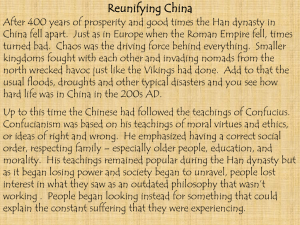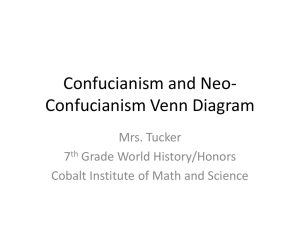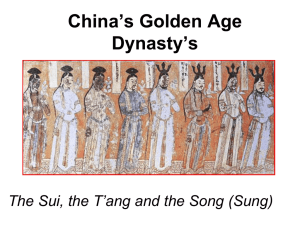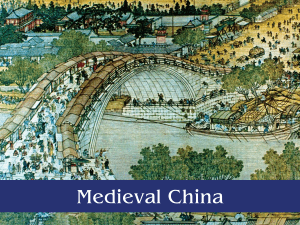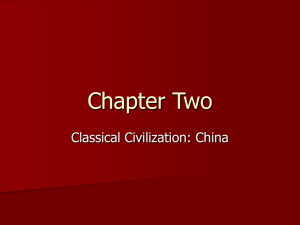Dynasties of China
advertisement
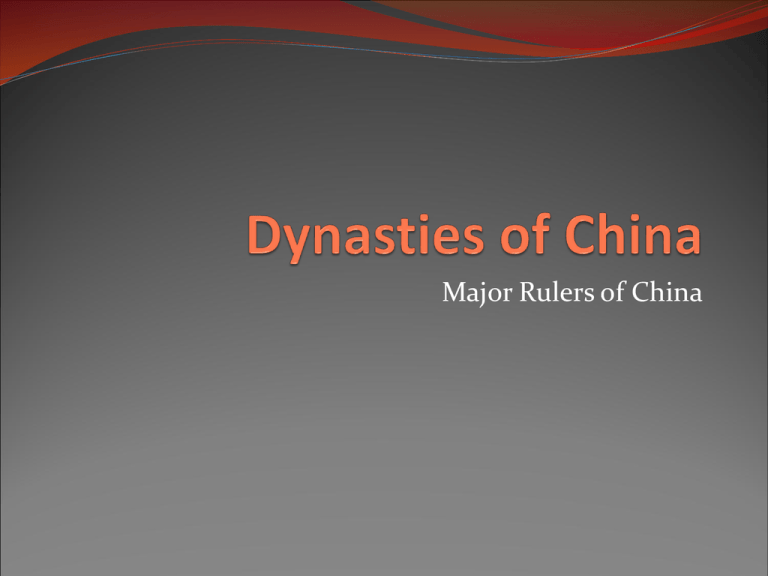
Major Rulers of China The First Emperor The first dynasty of China was led by prince Zheng, the head of the Qin state. He unified his empire by defeating other provinces of China. From that point forward China usually had an imperial government with many departments (bureaucracy). Dynastic China Chinese emperors usually named their sons to become emperor after death. Rulers based their right to govern on the idea of the Mandate of Heaven – which meant that Heaven had chosen them to rule. The Han Dynasty After the fall of the Qin Dynasty, the Han Dynasty took over. They lasted for over 400 years until they eventually lost power due to corrupt officials – usually relatives of the emperor, that abused their power as government officials. The Han continued The high taxes, forced labor on public projects, and bandits attacking the countryside caused the Han government to grow weak – eventually they could not protect their farmers and the farmers rebelled. Changes in Belief Systems The chaos after the fall of the Han Dynasty led to major changes in China’s belief system. Confucianism, Buddhism, and Daoism had great influence on the society of China. Confucianism Confucianism is based on the teachings of Confucius. He was a scholar who taught about right and wrong (morals and ethics). Confucianism focuses on: Using right relationships to help social order Respect for family and older generations Education of individuals and society Acting morally Confucianism continued The Han Dynasty used people who had been taught Confucian ideals to help run the government – this way the government was run by educated people. After the Han fell, Confucianism lost influence. Why would that be important? Buddhism Once Confucianism lost influence, Buddhism took its place. Buddhism was started by Siddhartha Gautama in India. Buddhism teaches: Suffering is a part of life People suffer because they are attached to material possessions and selfish ideas By living a wise, moral, and thoughtful life you can escape suffering. Daoism Daoism also had influence in China. It is a belief system that seeks harmony with nature and inner feelings. It began in China in the 500’s B.C. Changes in Thought Daoism, Buddhism, and Confucianism blended many of their beliefs and eventually Confucian thought changed from a set of political and ethical principles to a more personal and behavior based system (Neo-Confucianism). Education was the most important part of these principles. The Sui Dynasty After about 350 years of chaos after the fall of the Han, The Sui Dynasty reunified China. A general from northern China named Yang Jian took power by killing his grandson and conquering the south. He later became known as Wendi. Sui continued Wendi helped to make China strong and unified again. He allowed people to follow whatever beliefs system they wanted, centralized the government, increased public projects, and made people take tests for government jobs again. Sui Dynasty ends Unfortunately, he also raised taxes to pay for public projects like the Grand Canal, which connected the Yangtze and Yellow Rivers. High taxes caused the people to rebel (again) and the dynasty came to an end in just 37 years. The Tang Dynasty The Tang Dynasty followed the Sui in 618 and lasted for over 300 years. The dynasty expanded the borders and the road and canal system, and developed one of the most advanced and complex governmental systems in the world at the time. Tang Continued Some of the important accomplishments of the Tang Dynasty were a new law code and an expanded exam system in the Chinese government. If you passed the exam, you could become a ScholarOfficial The Song Dynasty The Song Dynasty did many of the same things that the Tang Dynasty did – including the expansion of the exam system to include practical subjects, but most officials continued to come from wealthy families who could afford education. Song Continued Under the Tang and Song Dynasties – the transportation around the country was made easier by roads and canals – this led to more trade and easier communication. Eventually new industries grew – from paper making to ship building. The Mongols A nomadic group of invaders from the North of China took control of the area in the 1200’s. They were called the Mongols. This was an era of foreign rule in China that lasted until 1368 when the Ming Dynasty overthrew them.

